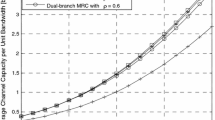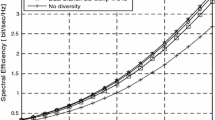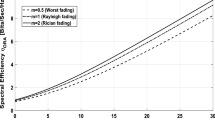Abstract
Various papers on the channel capacity using different diversity combining techniques and/or adaptive transmission schemes are available to enhance channel capacity under fading environment without the necessity of increasing bandwidth and transmit powers. This paper provides the review on the channel capacity of MRC (Maximal ratio combining) over uncorrelated and correlated Nakagami-m fading channels with m = 1 (Rayleigh fading channel) under ORA (Optimum rate adaptation with constant transmit power), CIFR (Channel inversion with fixed rate) and OPRA (Optimum power and rate adaptation) schemes. We also highlight the effect of fade correlation on channel capacity and discuss the improvement of the system performance under the different adaptive techniques.




Similar content being viewed by others
References
Khatalin, S., & Fonseka, J. P. (2006). Capacity of correlated Nakagami-m fading channels with diversity combining techniques. IEEE Transactions on Vehicular Technology, 55(1), 142–150.
Khatalin, S., & Fonseka, J. P. (2007). Channel capacity of dual-branch diversity systems over correlated Nakagami-m fading with channel inversion and fixed rate transmission scheme. IET Communications, 1(6), 1161–1169.
Goldsmith, A. J., & Varaiya, P. P. (1997). Capacity of fading channels with channel side information. IEEE Transactions on Information Theory, 43(6), 1986–1992.
Simon, M. K., & Alouini, M. S. (2005). Digital communication over fading channels (Vol. 95). New York: Wiley.
Kumar, S. (2015). Wireless communications fundamental and advanced concepts: Design planning and applications (Vol. 41). Aalborg: River Publishers.
Alouini, M. S., & Goldsmith, A. J. (1999). Capacity of Rayleigh fading channels under different adaptive transmission and diversity-combining techniques. IEEE Transactions on Vehicular Technology, 48(4), 1165–1181.
Alouini, M. S., & Goldsmith, A. (1997). Capacity of Nakagami multipath fading channels. In IEEE 47th vehicular technology conference, 1997, (Vol. 1, pp. 358–362). IEEE.
Shao, J. W., Alouini, M. S., & Goldsmith, A. J. (1999). Impact of fading correlation and unequal branch gains on the capacity of diversity systems. In IEEE 49th vehicular technology conference, 1999 (Vol. 3, pp. 2159–2163). IEEE.
Mallik, R. K., & Win, M. Z. (2000). Channel capacity in evenly correlated Rayleigh fading with different adaptive transmission schemes and maximal ratio combining. In Proceedings of IEEE international symposium on information theory (ISIT' 00), Sorrento. Italy (p. 412)
Mallik, R. K., Win, M. Z., Shao, J. W., Alouini, M. S., & Goldsmith, A. J. (2004). Channel capacity of adaptive transmission with maximal ratio combining in correlated Rayleigh fading. IEEE Transactions on Wireless Communications, 3(4), 1124–1133.
Subadar, R., & Sahu, P. R. (2010). Capacity analysis of dual-SC and-MRC systems over correlated Nakagami-m fading channels with non-identical and arbitrary fading parameters. In National conference on communications (NCC), 2010 (pp. 1–5). IEEE.
Khatalin, S., & Fonseka, J. P. (2006). On the channel capacity in Rician and Hoyt fading environments with MRC diversity. IEEE Transactions on Vehicular Technology, 55(1), 137–141.
Hasan, M. I., & Kumar, S. A. N. J. A. Y. (2014). Channel capacity of dual-branch maximal ratio combining under worst case of fading scenario. WSEAS Transactions on Communications, 13, 162–170.
Hasan, M. I., & Kumar, S. (2015). Average channel capacity of correlated dual-branch maximal ratio combining under worst case of fading scenario. Wireless Personal Communications, 83(4), 2623–2646.
Hasan, M. I., & Kumar, S. (2015). Average channel capacity evaluation for selection combining diversity schemes over Nakagami-0.5 fading channels. International Journal of Communication Networks and Information Security (IJCNIS), 7(2), 123–130.
Hasan, M. I., & Kumar, S. (2015). Spectral efficiency evaluation for selection combining diversity schemes under worst case of fading scenario. International Journal of Communication Networks and Information Security, 7(3), 123.
Hasan, M. I., & Kumar, S. (2017). Spectral efficiency of dual diversity selection combining schemes under correlated Nakagami-0.5 fading with unequal average received SNR. Telecommunication Systems, 64(1), 3–16.
Cheng, J., & Berger, T. (2003). Capacity of Nakagami-q (Hoyt) fading channels with channel side information. In International conference on communication technology proceedings, 2003. ICCT 2003 (Vol. 2, pp. 1915–1918). IEEE.
Da Costa, D. B., & Yacoub, M. D. (2007). Average channel capacity for generalized fading scenarios. IEEE Communications Letters, 11(12), 949–951.
Pena-Martin, J. P., Romero-Jerez, J. M., & Tellez-Labao, C. (2013). Performance of TAS/MRC wireless systems under Hoyt fading channels. IEEE Transactions on Wireless Communications, 12(7), 3350–3359.
Aalo, V. A. (1995). Performance of maximal-ratio diversity systems in a correlated Nakagami-fading environment. IEEE Transactions on Communications, 43(8), 2360–2369.
Hamdi, K. A. (2008). Capacity of MRC on correlated Rician fading channels. IEEE Transactions on Communications, 56(5), 708–711.
Annavajjala, R., & Milstein, L. B. (2004, March). On the capacity of dual diversity combining schemes on correlated Rayleigh fading channels with unequal branch gains. In 2004 IEEE wireless communications and networking conference, 2004. WCNC (Vol. 1, pp. 300–305). IEEE.
Alouini, M. S., & Simon, M. K. (1998). Multichannel reception of digital signals over correlated Nakagami fading channels. In Proceedings of the annual allerton conference on communication control and computing (Vol. 36, pp. 146–155). University of Illinois.
Lee, W. C. (1990). Estimate of channel capacity in Rayleigh fading environment. IEEE Transactions on Vehicular Technology, 39(3), 187–189.
Gunther, C. G. (1996). Comment on estimate of channel capacity in Rayleigh fading environment. IEEE Transactions on Vehicular Technology, 45(2), 401–403.
Yao, Y. D., & Sheikh, A. (1993). Evaluation of channel capacity in a generalized fading channel. In 43rd IEEE vehicular technology conference, 1993 (pp. 134–137). IEEE.
Alouini, M. S., & Goldsmith, A. (1997). Capacity of Nakagami multipath fading channels. In IEEE 47th vehicular technology conference, 1997 (Vol. 1, pp. 358–362). IEEE.
Alouini, M. S., Abdi, A., & Kaveh, M. (2001). Sum of gamma variates and performance of wireless communication systems over Nakagami-fading channels. IEEE Transactions on Vehicular Technology, 50(6), 1471–1480.
J. Cheng, T. Berger (2001). Capacity of a class of fading channels with channel state information (CSI) feedback. In Proceedings 39th annual allerton conference on communication, control, and computing (Allerton’01), Monticello, IL, USA, October 3–5.
Wolfram, The Wolfram function site (2015), Internet (online). http://functions.wolfram.com.
Gradshteyn, I. S., & Ryzhik, I. M. (2000). Table of integrals, series, and products. New York: Academic Press.
Author information
Authors and Affiliations
Corresponding author
Rights and permissions
About this article
Cite this article
Devi, P.B., Yengkhom, A., Hasan, M.I. et al. Capacity of Dual Branch MRC System Over Correlated Nakagami-m Fading Channels-A Review. Wireless Pers Commun 98, 1735–1752 (2018). https://doi.org/10.1007/s11277-017-4942-4
Published:
Issue Date:
DOI: https://doi.org/10.1007/s11277-017-4942-4




